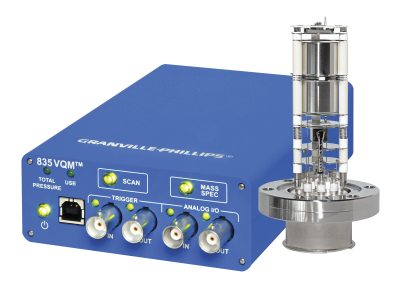Sorry, this family of products is no longer available. For recommended replacements see residual-gas-analyzers.
Granville-Phillips® 835 Vacuum Quality Monitor System
Overview
Please Note
Replacment parts for the 835 Vacuum Quality Monitor are still available from MKS, and can be found on this page: Vacuum Quality Monitor System Components
The Granville-Phillips® Series 835 Vacuum Quality Monitor (VQM™) combines the highest performance gas analysis technology with intelligent functional design that transforms complex measurement into actionable information. The 835 VQM is a low power mass spectrometer with full data collection, spectral deconvolution, and data logging at 85 ms capture rates for the full 1-145 amu measurement range or 125 ms for 1-300 amu.
Specifications
-
Mass Range1-145 amu in 85 ms
1-300 amu in 120 ms -
Data I/OUSB 2.0, full speed, 12 Mb/sec
-
Trigger In (BNC)50 ohm, positive TTL edge trigger, 1 ms minimum
-
Trigger Out (BNC)50 ohm, active high, TTL, frame scan, or VQI status
-
Analog In (BNC)10K ohm, 0-10 V, 12 bit resolution
-
Analog Out (BNC)0 to +5 V with 30 KHz 3 db bandwidth, raw data scan output
-
Front Panel LEDsExT TP, USB, Trigger IN, Trigger OUT, Analog IN, Analog OUT
-
Operating Temperature0° to 40°C (32°F to 104°F)
-
Storage Temperature0° to 80°C (32° to 176°F)
-
Relative Humidity<90%, non-condensing
-
Dimensions178.5 x 104.9 x 40.1 mm (7.03 x 4.13 x 1.58 inches)
-
Weight720 grams (25 ounces)
-
ComplianceCE
-
Gas Display TableAutomatic listing by amu or gas type (user selectable)
-
Input Power PlugDC power jack, 5.5 mm OD x 2.5 mm ID x 11 mm long
Resources
Literature
- 835 Vacuum Quality Monitor System (Archive) (367.1 kB, PDF)
Manuals
- 830/835 VQM Filament Replacement Instructions (322.3 kB, PDF)
- 830 to 835 VQM Upgrade Guide (95.8 kB, PDF)
- 835 VQM® Software Release Notes (289.6 kB, PDF)
- 835 VQM® User Manual (5.8 MB, PDF)
- 835 VQM® System >3 meter MS Controller-to-Gauge Interconnect Cable Optimization (129.7 kB, PDF)
- VQM® Electron Multiplier Replacement Instructions (649 kB, PDF)
- 835 VQM® Differential Pumping System Manual (1.2 MB, PDF)
- 835 VQM® Programmers Reference Manual (1.1 MB, PDF)



 Ultra-High Velocity
Ultra-High Velocity